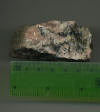

Back to Our Egypt Trip

 This
quarry is surrounded by the modern city of Aswan.
This
quarry is surrounded by the modern city of Aswan.

 In the Nubian Museum, there is a map showing other quarries in
the area. Larry counted 111 quarries on that map.
In the Nubian Museum, there is a map showing other quarries in
the area. Larry counted 111 quarries on that map.
 This is the tip of the Unfinished Obelisk, at Aswan. You can
see the method of hammering the granite with hammerstones like these.
This is the tip of the Unfinished Obelisk, at Aswan. You can
see the method of hammering the granite with hammerstones like these. Thousands of these hammerstones were found on the site.
The technique, was to use a diorite hammerstone to hammer a 12 inch hole, 8 feet
deep, every 4 or 5 feet, around the entire perimeter of the obelisk. That,
supposedly, would ensure that the material was suitable to create an obelisk
with no flaws or cracks. That must have been difficult enough, but then, they
connected those holes by hammering new ones, until the entire obelisk was
roughed out. The next task was to dislodge the obelisk from it's granite matrix.
It is thought, that they may have cut holes underneath the stone, inserted
wooden blocks, and added water to make the wood swell and release the stone.
Other ideas include hammering horizontal holes every so often, then sawing from
one hole to another. As a flintknapper, I can only guess at the amount of dust,
workmen would breath in, in a day. Silicosis must have been a great scourge for
them. Any way you look at it, this must have been a very
difficult undertaking.
Thousands of these hammerstones were found on the site.
The technique, was to use a diorite hammerstone to hammer a 12 inch hole, 8 feet
deep, every 4 or 5 feet, around the entire perimeter of the obelisk. That,
supposedly, would ensure that the material was suitable to create an obelisk
with no flaws or cracks. That must have been difficult enough, but then, they
connected those holes by hammering new ones, until the entire obelisk was
roughed out. The next task was to dislodge the obelisk from it's granite matrix.
It is thought, that they may have cut holes underneath the stone, inserted
wooden blocks, and added water to make the wood swell and release the stone.
Other ideas include hammering horizontal holes every so often, then sawing from
one hole to another. As a flintknapper, I can only guess at the amount of dust,
workmen would breath in, in a day. Silicosis must have been a great scourge for
them. Any way you look at it, this must have been a very
difficult undertaking.
To transport the obelisk, a canal would have been cut, to the Nile, and a large boat would have been brought to the obelisk, using the canal. The obelisk would have been loaded on the boat and transported to it's final destination. There is a description of the quarrying and transport of 2 obelisks at Karnak, on the walls, of Hathepsut's Temple, at Dier el-Bahri.
This obelisk would have been the largest ever attempted, but it was found to have a crack so, it was abandoned. If completed, it would have been 138 feet tall and weighed over 1,197 tons. A lot of the obelisk tips were capped with gold.
